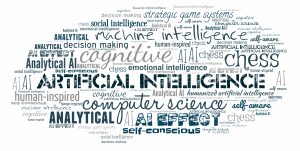19 Artificial Intelligence and Information
Learning Objectives
By the end of this chapter, students must be able to:
- Describe the role of Artificial Intelligence in Marketing Research
- Understand the benefits of Artificial Intelligence in Research
- Explain the limitations of Artificial Intelligence technology
Source: Digital Marketing Made Easy [1]
The following material is derived from Huang and Rust[2] and is used under a Creative Commons Attribution ShareAlike 4.0 Licence.
Artificial intelligence (AI) in marketing is currently gaining importance, due to increasing computing power, lower computing costs, the availability of big data, and the advance of machine learning algorithms and models. We see wide applications of AI in various areas of marketing. For example, Amazon.com’s Prime Air uses drones to automate shipping and delivery. Domino’s pizza is experimenting with autonomous cars and delivery robots to deliver pizza to the customer’s door.
Artificial intelligence (AI) refers to intelligence demonstrated by machines, as opposed to the natural intelligence displayed by humans and animals. Artificial Intelligence is, machines behaving intelligently and undertaking problem-solving or completing tasks. It is a very broad subject that involves computer science, cognitive science, mathematics, philosophy, neuroscience, linguistics, etc.
Artificial Intelligence (AI) and Marketing Research
AI can be used in three different ways in marketing research: a) data collection; b) market analysis; and c) understanding the customer and developing key insights.
AI and Data Collection:
AI can automate data collection about the market, the environment, the firm, the competitors, and the customers. In the digitally connected world, market data can be easily tracked and monitored. Data sensing, tracking, and collection are routine, repetitive tasks that can be easily automated via AI. Existing studies have shown various ways of using AI for data collection. For example:
- customer intelligence, including data about consumers, their activities, and their environments, can be collected if they use connected devices (e.g., wearable devices, smart fridges, and digital assistants such as Siri)
- product usage and consumption experience can be visualized with Internet of Things (IoT)
- various advanced technologies and analytics can capture unstructured marketing activity data
- in-car sensors can track driving behavior for determining insurance premiums
- retail technologies, such as heat maps, video surveillance, and beacons, can be used for profiling and recognizing retail shoppers
Previous studies show that, given the repetitive, routine, but high-volume nature of market data, AI can collect data efficiently at scale. The data collection capability of AI is not limited to observable behavioral data; it can also be used to facilitate survey or experimental data collection to capture consumer psychographics, opinions, and attitudes. For example, human administration and supervision of ongoing surveys are no longer required and can be automated. SurveyMonkey and SurveyCake are two commercial survey platforms that automate survey design and data collection. By incorporating the principles of gaming and AI better quality data is being collected online. Online surveys have become more fun and engaging. Survey participants are also more likely to complete such surveys and recommend them to others. In fact, by using AI technology, researchers believe that in the next few years, nearly 1 in 4 surveys will be spoken to a digital assistant (Qualtrics 2022).
AI and Data Analysis:
AI can be used to analyse information. Here are a few examples of how researchers have used AI to undertake analysis:
- Automated text analysis is applied to gain insights into consumers’ behaviour (e.g., by analysing customer reviews on a website)
- Machine learning algorithms and lexicon-based text classification is used to analyse various social media datasets
- Big data marketing analytics is a mainstream approach for generating marketing insights. Specific applications include mapping market structures for large retail assortments using a neural network language model, by analyzing the co-occurrences of products in shopping baskets, detecting copycat mobile apps using a machine learning copycat-detection method, and aiding social media content engineering by employing natural language processing algorithms that discover the associations between social media marketing content and user engagement
AI and Improved Understanding of the Customer:
AI can be used to understand existing and potential customer needs and wants, for example, who they are, what they want, and what their current solutions are. The major distinction between market analysis and customer understanding is that the latter often involves emotional data about customer sentiments, feelings, preferences, and attitudes. Thus, AI does not only churn out quick numbers, it also has the capability of analyzing emotional data. For example, Affectiva partnered with Ford to create AutoEmotive sentiment analysis, to try to figure out drivers’ emotional states.
For potential customers, marketers can use feeling AI to understand what they want and why they are happy with competitors or outside options. Some marketers may feel that potential customers’ needs and wants are more difficult to predict as their emotional data is less available. However, Unilever has proved otherwise. With the help of AI data centers, Unilever synthesized insights through social listening and CRM, and discovered a link between ice cream and breakfast. Unilever discovered that there were at least 50 songs with ‘ice cream for breakfast’ in their lyrics (which people were listening to), as well as Dunkin Donuts selling ice cream during the morning part. With this insight, Unilever developed a new brand Ben & Jerry’s with a range of cereal-flavored ice-creams for breakfast.
Limitations of Artificial Intelligence

Financial and Human Resource Cost:
Using AI requires financial and human resources. The initial cost of setting up an AI infrastructure is always resource-intensive. Thus, it may not be feasible for all organisations. Investing in AI can mean heavy expenditures on data acquisition, computing, and storage equipment, as well as spending on recruiting relevant personnel and training them. As with all investments, the returns may not be immediate. It may take a while to realise the benefits of using AI.
AI systems should not be seen as a replacement for human capital. In fact, AI systems only work best when it is best integrated with the expertise of the organisation. It is not advisable to leave customers or suppliers at the mercy of a ‘digital assistant’. There are numerous case studies that demonstrate the limitation of such an approach.
Unrealistic Expectations from AI/Threatened by AI:
At times, managers can have unrealistic expectations from AI technologies. Not all aspects of AI will add value to all business operations. Managers need to analyse what is feasible for achieving specific objectives. The author of this book has worked in the area of social robotics. Deploying a social robot within a business environment often posed challenges. Either the expectations of the business managers were too high for the social robot (e.g., “will it be able to answer the phone?”) or – in some cases – it did not help with their overall communication objectives. In another few cases, employees were threatened with the arrival of a social robot as they feared job losses. In many instances, the overall evaluation of the technology was undertaken by individuals who may have had a bias towards the use of the machine.
- Digital Marketing Made Easy 2021, Artificial intelligence explained in 3 minutes: 3 applications in marketing, 14 May, online video, viewed 10 May 2022, <https://www.youtube.com/watch?v=jBaH_g4QKAc>. ↵
- Huang, MH & Rust, RT 2020, 'A strategic framework for artificial intelligence in marketing', Journal of the Academy of Marketing Science, vol. 49, pp. 30-50, viewed 11 May 2022, <https://link.springer.com/article/10.1007/s11747-020-00749-9> ↵

